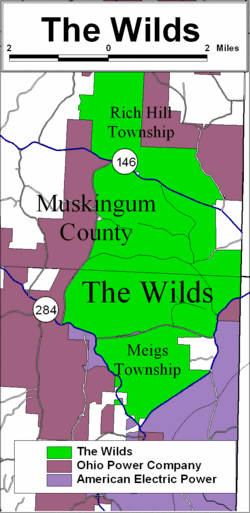The Wilds
_logo.jpg) | |
| Date opened | 1994 |
|---|---|
| Location | Cumberland, Ohio, United States |
| Coordinates | 39°49′33″N 81°44′51″W / 39.82571°N 81.747637°WCoordinates: 39°49′33″N 81°44′51″W / 39.82571°N 81.747637°W |
| Land area | 9,154 acres (37.04 km2) |
| Number of animals | >300 |
| Number of species | <25 |
| Website |
thewilds |
The Wilds is a private, non-profit safari park and conservation center that combines cutting-edge conservation science and education programs with hands-on experiences and one-of-a-kind adventures that include ziplining, horseback riding, fishing and more. Located in Cumberland, Ohio, the Wilds is home to rare and endangered species from the globe living in natural, open-range habitats.
The property encompasses 9,154 acres of reclaimed coal mine land and includes 2,000 acres of pastures and a 27-acre Carnivore Conservation Center. The Wilds is designated an Audubon Important Bird Area so the property includes a birding station with covered lookout as well as a butterfly habitat with hiking trails, more than 15 miles of mountain bike and hiking trails and approximately 150 lakes.
The Wilds is the largest wildlife conservation center in North America and is open between the months of May and October.
The Park was made on reclaimed land dug by the dragline Big Muskie.
History


In 1984, the Wilds was incorporated as a 501(c)(3) non-profit under the name The International Center for the Preservation of Wild Animals, Inc. (ICPWA), formalizing a public-private partnership involving the Ohio Departments of Natural Resources and Development, the Ohio Zoos and the private sector that formed in the late-1970s. That same year, the Wilds was gifted its current 9,154 acres from the Central Ohio Coal Company. With a location secured, the Wilds began hiring employees, planning development, and organizing fundraising support.
In 1989, the Johnson Visitor Center was completed, built with the environment in mind using a state-of-the-art geothermal heating and cooling system. In 1990, the first animal management facilities and fencing of the initial open range began. These projects allowed for the Wilds to receive its first animals, Przewalski’s horses in 1992.
The Wilds officially opened to the public for tours in 1994. For the next few years, it continued to add animals, improve and expand conservation efforts, and increase public awareness. In 2001, the Wilds began its partnership with the Columbus Zoo and Aquarium. This culminated in the completion of the first Strategic Vision Plan in 2005, designed to guide the success and future development of the Wilds for the future.
Today, the Wilds continues working on its mission to advance conservation through science, education and personal experience.
Strategic plan
In 2005, the Wilds initiated its long-term strategic plan, which is broken into "strategic centers" to facilitate progress in each field. These "centers" are based on the Wilds' core values, which include a commitment and respect for nature, social and scientific relevance, and innovative, entrepreneurial and creative approaches to the problem at hand. The strategic centers are focused on animal management, science and research, conservation education & professional training, land stewardship and habitat management, personal experience, institutional partnerships, and resource development & sustainability.[1]
Conservation
The Wilds is involved in many different conservation methods in an attempt to help reduce the decline of wildlife habitats. These methods range from professional training to animal husbandry to conservation medicine.
In order to help the development of conservation medicine, The Wilds has started three projects they hope will be models for the conservation medicine initiative as a whole. These include assessing water quality and its effects on marine life, comparing animal health parameters in multiple habitats, and evaluating fresh water mussels for diseases, parasites and toxins. Each of these projects is designed to assess the condition of various wildlife and their habitats, and to develop methods to reduce or reverse the destruction of each ecosystem.[2]
Managed species
- African wild dog
- American bison
- American burying beetle
- Bactrian camel
- Bactrian deer
- Banteng
- Cheetah
- Chinese goral
- Common eland
- Dhole
- Eld's deer
- Freshwater bivalve
- Fringe-eared oryx
- Grevy's zebra
- Hellbender
- Indian rhinoceros
- Masai giraffe
- Ostrich
- Pere David's deer
- Persian onager
- Przewalski's horse
- Red-crowned crane
- Reticulated giraffe
- Rothschild giraffe
- Sable antelope
- Scimitar-horned oryx
- Sichuan takin
- Southern white rhinoceros
- Trumpeter swan
- Vietnamese sika deer
Gallery

Notes
- ↑ "the Wilds Strategic Plan". the Wilds. 2007. Retrieved 2007-04-01.
- ↑ "the Wilds Conservation Medicine". the Wilds. 2007. Retrieved 2007-04-01.
External links
| Wikimedia Commons has media related to The Wilds. |